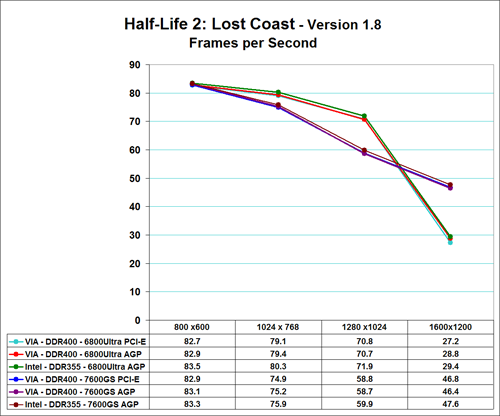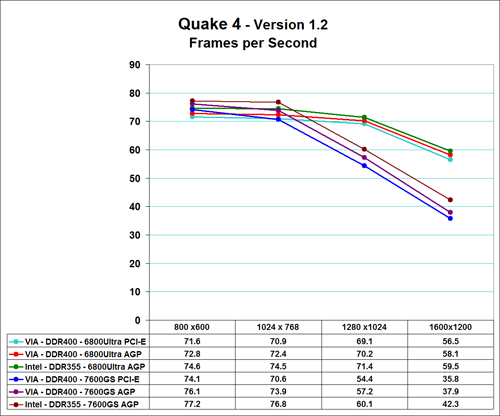ASRock Core 2 Duo: AGP/PCI Express Graphics Performance, Part Tres
by Gary Key on August 15, 2006 6:30 AM EST- Posted in
- Motherboards
Graphics Performance Comparison
While our previous articles concentrated on memory performance, today's article solely consists of gaming benchmarks and the synthetic 3DMark tests from Futuremark. The 3DMark series of benchmarks developed and provided by FutureMark are among the most widely used tools for benchmark reporting and comparisons. Although the benchmarks are very useful for providing consistent comparisons across a broad array of GPU and CPU configurations they are not a substitute for actual application and gaming benchmarks. In this sense we consider the 3DMark benchmarks to be purely synthetic in nature.
The gap between PCI-E and AGP solutions is less than 2% with both video card choices. Our first tests show AGP performing slightly better than PCI-E on the VIA platform with the Intel platform performing better overall. The 6800 Ultra series outperforms the 7600GS up to 38% in 3DMark05 and 26% in 3DMark06. Let's see if these differences carry over into our game benchmarks.
We utilized Far Cry, Half Life 2 and Quake 4 in our memory test articles because they are sensitive to memory changes and potentially bus throughput issues in our comparison. We added Prey and Serious Sam 2 to our benchmark mix because they are typically very GPU dependent and scale well. We originally tested at both 1024x768 and 1280x1024 resolutions at High Quality settings without anti-aliasing or antistrophic filtering enabled. We have also added 800x600 and 1600x1200 resolutions with the same settings.
Our three memory sensitive games show a consistent pattern with the AGP capability of the ASRock 775Dual-VSTA performing up to 5% higher than the PCI-E version in our testing. Overall, the AGP slot performance is better than the PCI Express slot even in 800x600 testing where the X4 operation handicap should not make a difference. The Intel 865 chipset offers better AGP performance especially as the resolutions start to scale upward. Looking at the gaming results from our previous article, the X16 PCI-E solutions typically offer equal or better performance than the AGP offerings. Whether it's the extra bandwidth or simply a less-than-perfect PCI-E implementation on the 775Dual-VSTA we can't say without further testing. However, the bottom line is that AGP performance is better than PCI-E performance on this particular motherboard.
The 6800 Ultra is still a very competitive card when compared to the 7600GS in these particular benchmarks, although it stumbles at 1600x1200 in Half Life 2- Lost Coast. The ATI X850XT-PE would score in a similar fashion if not better than the 6800 Ultra, though of course it lacks SM3.0 support which can be useful in more recent titles. Those owners with a graphics card in this class can still get by with most of today's games. We will have Oblivion results in our final article although we highly suggest going with a different solution to play this game at decent settings
While our previous articles concentrated on memory performance, today's article solely consists of gaming benchmarks and the synthetic 3DMark tests from Futuremark. The 3DMark series of benchmarks developed and provided by FutureMark are among the most widely used tools for benchmark reporting and comparisons. Although the benchmarks are very useful for providing consistent comparisons across a broad array of GPU and CPU configurations they are not a substitute for actual application and gaming benchmarks. In this sense we consider the 3DMark benchmarks to be purely synthetic in nature.
 |
| Click to enlarge |
The gap between PCI-E and AGP solutions is less than 2% with both video card choices. Our first tests show AGP performing slightly better than PCI-E on the VIA platform with the Intel platform performing better overall. The 6800 Ultra series outperforms the 7600GS up to 38% in 3DMark05 and 26% in 3DMark06. Let's see if these differences carry over into our game benchmarks.
We utilized Far Cry, Half Life 2 and Quake 4 in our memory test articles because they are sensitive to memory changes and potentially bus throughput issues in our comparison. We added Prey and Serious Sam 2 to our benchmark mix because they are typically very GPU dependent and scale well. We originally tested at both 1024x768 and 1280x1024 resolutions at High Quality settings without anti-aliasing or antistrophic filtering enabled. We have also added 800x600 and 1600x1200 resolutions with the same settings.
 |
 |
 |
| Click to enlarge |
Our three memory sensitive games show a consistent pattern with the AGP capability of the ASRock 775Dual-VSTA performing up to 5% higher than the PCI-E version in our testing. Overall, the AGP slot performance is better than the PCI Express slot even in 800x600 testing where the X4 operation handicap should not make a difference. The Intel 865 chipset offers better AGP performance especially as the resolutions start to scale upward. Looking at the gaming results from our previous article, the X16 PCI-E solutions typically offer equal or better performance than the AGP offerings. Whether it's the extra bandwidth or simply a less-than-perfect PCI-E implementation on the 775Dual-VSTA we can't say without further testing. However, the bottom line is that AGP performance is better than PCI-E performance on this particular motherboard.
The 6800 Ultra is still a very competitive card when compared to the 7600GS in these particular benchmarks, although it stumbles at 1600x1200 in Half Life 2- Lost Coast. The ATI X850XT-PE would score in a similar fashion if not better than the 6800 Ultra, though of course it lacks SM3.0 support which can be useful in more recent titles. Those owners with a graphics card in this class can still get by with most of today's games. We will have Oblivion results in our final article although we highly suggest going with a different solution to play this game at decent settings










43 Comments
View All Comments
atlr - Thursday, January 25, 2007 - link
Has anyone compared the performance of agp and pci-e versions of the x1950pro on the Asrock Dual-VSTA?I am wondering if the 4x PCI-E on the Asrock will be a noticeable bottleneck with a GPU faster than the 6800Ultra.
mongo lloyd - Tuesday, August 22, 2006 - link
Does anyone know of a board similar to the i865PE-based Asrock board, released or upcoming, that basically has the same features only with gigabit LAN? Intel CSA preferred, but even gigabit hanging off the PCI bus would be better than the 10/100 crap. It's a must for me, and such a board would make an upgrade really desirable.hibachirat - Tuesday, August 22, 2006 - link
I think you'll have a hard time finding an AGP & DDR intel Conroe supporting mobo with built-in gigabit LAN. mATX too? No hope, but you could get one of these and then add an ethernet card like we used to do in times of yore.Sc4freak - Saturday, August 19, 2006 - link
"Three" in French is "trois". "Tres" means "very"."ASRock Core 2 Duo: AGP/PCI Express Graphics Performance, Part Very" :p
Un, deux, trois, quatre, cinq, six, sept, huit, neuf, dix.
Gary Key - Sunday, August 20, 2006 - link
I know French, Tres is three in Spanish and hence the change up for our Spanish speaking friends. :)
lapierrem - Thursday, August 17, 2006 - link
I find it very amusing to see that AGP cards can still beat a PCI-e card which is supposed to be so much faster and better in many respects, but apparently isn't. I know on the other Asrock boards, like the 939DualSata2 the AGP is bridged off the PCI-E bus and is supposed to be slower, but wow. Maybe if we had gone with dual AGP cards for SLI we woulda had the real dealCrappyLuckMan - Thursday, August 17, 2006 - link
Anandtrash buys ascrock stock and bans me. Yey no more n00bs.CrappyLuckMan - Wednesday, August 16, 2006 - link
In all the asrock tests it's the Asrock that's a bottleneck. I believe the best way to bench is use a card that comes in both flavors and run it on an NF4 w/AM2 DDR-2 and one in an NF4 agp mobo with DDR. You test ram and video card this way at the same time on the same chipset and same cpu with same cache and same speed. Only difference is one is ddr-2 and has an extra pin.And from my experience with Asrock boards is that they die for no reason and wont boot no matter what you do after a while. You get what you pay for and I can't believe how much attention you are giving this cheapo mobo.
hibachirat - Friday, August 18, 2006 - link
Too bad your experience was negative, but I have had top of the line ASUS and AOPEN boards that were junk fresh out of the box. And problematic top of the line boards from MSI and Abit. Also had great boards from the same makers. Now I'm running some "cheap" boards from Asrock and Biostar that are rock solid. The difference between the high end and low end boards has more to do with cutting edge feature sets and fractional performance gains than it does with stability and longevity. Asrock may be soft-rock to the T-O-L boards heavy metal, but that suits some of us just fine.CrappyLuckMan - Saturday, August 19, 2006 - link
Well then again I see on newegg a lot of people use junk ram and or crappy psu's and call the mobo junk cause it doesn't post. Even if the asrock posts and doesn't die in a year, I still think it is a bottleneck and it shouldn't be used to compare agp vs pci x16.